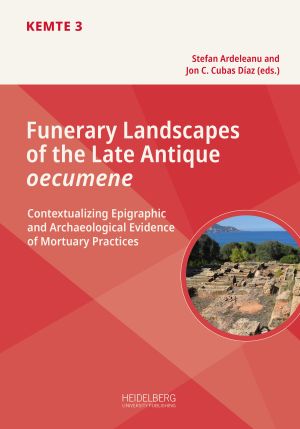Zitationsvorschlag
Lizenz (Kapitel)

Dieses Werk steht unter der Lizenz Creative Commons Namensnennung - Weitergabe unter gleichen Bedingungen 4.0 International.
Identifier (Buch)
Veröffentlicht
Bestattung und Kommemoration im frühchristlichen Hispanien
Materielle, ikonographische und inschriftliche Aspekte
Abstract The present contribution sets out to provide a panoramic overview of Hispanic funerary spaces and burial habits. Its chronological frame includes the whole of Late Antiquity (4th to 7th, but especially the 5th and 6th c. AD) and it takes into account a wide range of social groups, most of which were progressively christianized. The only painful lacuna in this panorama consists of the Visigothic royal tombs, as it is still impossible, unfortunately, to describe their local and formal characteristics. The most spectacular and earliest testimonies of the transition to Christianity are the City-of-Rome type sarcophagi with their figurative reliefs, followed by clearly autochthonous pieces and by other imported examples from North Africa and Gaul. Of course, all of these decorated sarcophagi are overwhelmingly outnumbered by (nearly) undecorated monolithic containers of local production. At the same time, mausolea continued to serve as accommodation for privileged burials. Although the old custom of celebrating funerary meals was censured by the Church, its traces can be detected at several places. Occasional efforts to prohibit interments within church buildings remained largely ineffective. The ancient prohibition to bury the dead within the urban pomerium gradually grew weaker, also on the Iberian Peninsula, from the 5th c. AD onwards. The materiality of the inhumations, which normally have a west-east orientation, tangibly illustrates the manifold levels of society, spanning from extreme poverty to noticeably elaborate constructions or even to the use of sarcophagi. Secondary burial was a common phenomenon. The inventory of personal outfits and dedicated depots ranges from many ordinary objects to some exceptionally rare findings of outstanding character. Beyond the individual case of a psalmic inscription found inside a tomb, which was restricted to the defunct person’s ‘privacy’, there are countless epigraphic and iconographic messages. The most prominent may be the funerary mosaics, including figurative examples. The funerary mosaics, the tombs decorated with opus signinum or inscribed slabs, as well as the visible lids of sunken sarcophagi, raise a special question: did these funerary monuments preserve the general floor level, or did they extend above the surface? Sometimes, the latter seems to be the case, as the evidence from different monuments suggests. As an illustration of especially instructive Hispanic sepulchral inscriptions, examples from Mértola (Lusitania) are presented. The paper ends with a discussion of the Pascentius epitaph from Torrebaja (Badajoz), extraordinarily rich in content.
Keywords Late Antique Hispaniae, funerary






